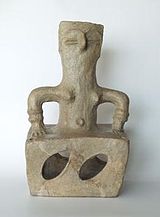**Group 1: Neolithic Cultural Characteristics and Expansion**
– Neolithic groups lived in small, family-based communities.
– Subsisted on domesticated plants, animals, wild plant foods, and hunting.
– Used hand-made pottery without a potter’s wheel.
– Utilized polished stone axes for forest clearance.
– Varied in size and mobility, from fortified settlements to mobile cattle-herders.
– Spread at an average speed of about 1km/yr.
– Neolithic expansion introduced cultural changes from southeast to northwest Europe.
– Duration of the Neolithic varied from 3,000 to 4,000 years in different European regions.
– Some parts of Europe transitioned to the Chalcolithic period due to copper tool usage.
**Group 2: Neolithic Social Organization, Subsistence Practices, and Decline**
– Neolithic peoples left no historical records.
– Archaeology provides insights into social organization and subsistence practices.
– Population genetics offer details on the population history of Neolithic Europe.
– Linguistics contribute to reconstructions of early European languages.
– Indo-European languages coincided with Neolithic expansion in Europe.
– Population levels rose rapidly at the beginning of the Neolithic.
– Population crash occurred after 5000 BC, with subsequent rises and falls.
– Neolithic decline around 2500 BC, possibly due to climatic conditions, plague, or migration.
**Group 3: Genetic and Archaeological Evidence**
– Genetic data suggest no independent animal domestication in Neolithic Europe.
– Broomcorn millet was the only non-Southwest Asia domesticate.
– Cheese-making dates back to 5500 BC in Poland.
– DNA studies indicate population replacement by Aegean Neolithic farmers.
– Radiocarbon dating shows coexistence of Mesolithic and Neolithic populations in Europe.
**Group 4: Neolithic Constructions and Related Topics**
– Various Neolithic constructions across Europe from c.5000 BCE onwards.
– List of notable Neolithic cultures and sites.
– Related topics include Prehistoric Europe, Chalcolithic Europe, and Indo-Iranians.
– References and additional sources detailing Neolithic research and findings.
**Group 5: Genetics, Language, and Migration in Neolithic Europe**
– Genetic studies show the contribution of Neolithic farmers to modern European populations.
– Neolithic farmers expanded from the Aegean and Near East.
– Evidence of genetic mixing between Western Hunter-Gatherers and Early European Farmers.
– Indo-European languages reached Europe during the Chalcolithic or Bronze Age.
– Migration patterns during the Chalcolithic and Bronze Age, impacting cultural mobility and linguistic diversity.
The European Neolithic is the period from the arrival of Neolithic (New Stone Age) technology and the associated population of Early European Farmers in Europe, c. 7000 BC (the approximate time of the first farming societies in Greece) until c. 2000–1700 BC (the beginning of Bronze Age Europe with the Nordic Bronze Age). The Neolithic overlaps the Mesolithic and Bronze Age periods in Europe as cultural changes moved from the southeast to northwest at about 1 km/year – this is called the Neolithic Expansion.


The duration of the Neolithic varies from place to place, its end marked by the introduction of bronze tools: in southeast Europe it is approximately 4,000 years (i.e. 7000 BC–3000 BC) while in parts of Northwest Europe it is just under 3,000 years (c. 4500 BC–1700 BC). In parts of Europe, notably the Balkans, the period after c. 5000 BC is known as the Chalcolithic (Copper Age) due to the invention of copper smelting and the prevalence of copper tools, weapons and other artifacts.
The spread of the Neolithic from the Pre-Pottery Neolithic in the Near East to Europe was first studied quantitatively in the 1970s, when a sufficient number of 14C age determinations for early Neolithic sites had become available. Ammerman and Cavalli-Sforza discovered a linear relationship between the age of an Early Neolithic site and its distance from the conventional source in the Near East (Jericho), thus demonstrating that the Neolithic spread at an average speed of about 1 km/yr. More recent studies confirm these results and yield a speed of 0.6–1.3 km/yr at a 95% confidence level.
